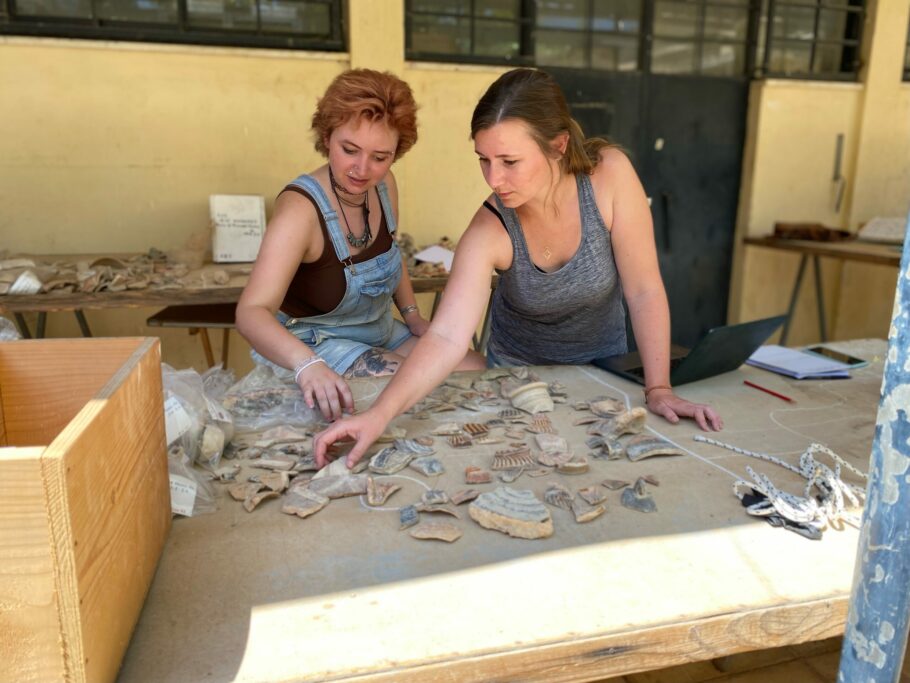KLASP 2023: The Second Season on Evans’s NW Treasure House
Launched in summer 2022, KLASP (Knossos Legacy and Sustainability Project) is a joined international effort that sees a collaboration between Tulane University (USA; Emilia Oddo), University College Dublin (Ireland; Joanna Day), and the University of Warwick (UK; Conor Trainor). The project is under the auspices of the British School at Athens. As implicit in its name, KLASP targets specifically the study of legacy material, focusing on the analysis of ceramic assemblages from different chronological periods (from Prepalatial through Neopalatial and down to Hellenistic times, ca. 3,000 BC-1st century AD). The reason for choosing Knossos as setting for the project is simple: with a long excavation history, and a deep pre-historic and historical occupation, the site provides access to much unpublished material from different periods of antiquity and excavated at different times during the 20th century.
This June 2023, the Tulane team of KLASP conducted the second study season on the pottery from the so-called NW Treasure House, a Neopalatial building excavated by A. Evans and D. Mackenzie in 1903. Under the direction of E. Oddo, a team of 6 students, undergraduate and graduates, gathered back around the sherds table of the Stratigraphical Museum to study the pottery form the Room of the Bronze Vases, which owes its name to the hoard of bronze vessels uncovered there. As part of KLASP’s overarching goals, the project has a twofold aim: to conduct fieldwork/new archaeological research that would provide the opportunity to continue contributing to our field; to involve undergraduate and graduate students, training them in ceramic analysis. The study of the hitherto unpublished NWTH enriches current research on Neopalatial Knossos, expanding our knowledge of the settlement articulation, particularly in the area NW and W of the Palace. The Warwick team is planning to work on a Roman pottery kiln during September 2023, with all three teams returning for a joint season in 2024.
There is a strong element of co-creation on KLASP. Specialists and students work side-by-side, and students of every level receive the opportunity to develop and understand the importance of ceramic analysis, a fundamental skill in the archaeology of any period. Students joining the team are chosen through an application and an interview process, which ensures they are motivated, genuinely interested in the work, as well as a good fit for the team. Once at Knossos, they are trained one-on-one and as a group on both the methods of ceramic processing and the way each informs different research questions and agendas. This approach encourages inquisitive and collaborative learning in a friendly environment, where the research potential of archaeological data is explored at its fullest.
This pedagogical formula has proven successful, as the students themselves report. Archaeology student Sean Peek (Tulane University) says this experience is allowing him to learn how “to categorise ancient material, and how to understand archeological assemblages” in our attempt “to truly flesh out antiquity”. Likewise, Felicity Sorenson remarks how the experience has opened up her understanding of the role pottery plays in reconstructing ancient societies: “the most interesting part has been seeing the wide variety of vessels. I think it is always exciting to find boxes containing different materials or unique shapes and decorations because I enjoy thinking about what role these unique pieces would have in Minoan society.” PhD student Kaarin Percy (University of Virginia), who has just completed her second season in the KLASP project, reflects on her experience saying how this second time around she has continued developing “the skills necessary for ceramic analysis on a deeper level. Rather than just recording individual aspects of the pottery, I am now learning to use the assemblage as a whole to identify trends.” The importance to work on legacy data from the Arthur Evans’ excavations is an untapped resource that students care about. Carolyn Dorey (PhD student at the University of North Carolina, Chapel Hill) comments: “As a graduate student studying archaeology, having the opportunity to work hands-on with material from Arthur Evans’ excavations is an invaluable experience. It is impossible to learn the intricacies of working with ceramics in a university classroom devoid of pottery, but working at Knossos has allowed me to begin to understand the processes of studying ceramics. Working at the Stratigraphical Museum is exciting because it involves not only learning about Minoan pottery but also the history of the excavations at Knossos and the original excavators of the site.”
If you are interested in joining for one of the upcoming seasons, please email eoddo@tulane.edu, C.Trainor@warwick.ac.uk, joanna.day@ucd.ie.
